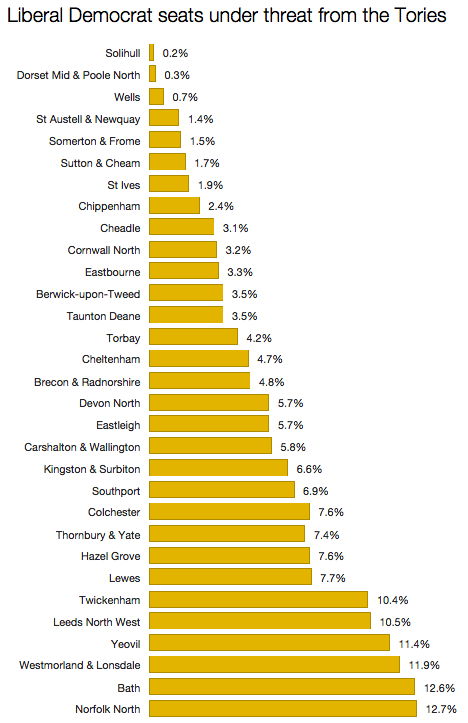Election campaign
Parties are advancing on the Lib Dems from four fronts: how many MPs will survive?
Academics from the British Election Study yesterday published what they called a “nowcast” (as opposed to a forecast) of the general election result. It caused quite a stir on social media, mainly because it suggested the Liberal Democrats were set to win just one seat. That’s right: one seat.
Jon Mellon from the BES offered a number of reasons for this startling assessment, including the way the study group calculates swing and the fact it uses polls based on standard voting intention rather than the “thinking of your own constituency” method preferred by people like Lord Ashcroft.
Mellon also conceded that voters “may focus more on [their] own MP closer to the election, but that’s not reflected in current data.”
A Liberal Democrat party reduced to just one MP sounds utterly absurd, though nothing is impossible when it comes to elections. In my most recent prediction I suggested the Lib Dems would hold 28 seats in the next parliament: down almost half on the number they won in 2010, but still above what many others have been forecasting.
To get a clearer idea of the challenge the Lib Dems are facing, as well as the likelihood of them losing even more than half their MPs, I’ve grouped their seats according to which party is posing the main threat.
First, the Lib Dem-Labour battleground:
There are really only 12 seats that Labour can hope to gain from the Lib Dems, and that includes the unlikely scenario of defeating Nick Clegg in Sheffield Hallam. A total of 12 is not many, and it’s worth remembering this. Losing seats to Labour is not as arithmetically decisive for the Lib Dems as losing seats to the Conservatives. Here’s why:
One of the most crucial factors that shapes the outcome of the election will be just how far down this list of 31 seats the Tories can go. At the moment I think they will only gain around a third of them. But you can see that a lot more could change hands on only moderately-sized swings. We know Labour will take pretty much all of its Lib Dem targets. How many will the Tories manage to grab?
As if that wasn’t enough of a headache for Nick Clegg, his party now faces a third threat in the shape of the SNP:
I handed eight of these seats to the SNP in my latest prediction. But as with Labour, there’s a relatively modest limit to the number of seats the Lib Dems could lose in Scotland. And I don’t think even the SNP can manage to take Orkney & Shetland, the Lib Dems’ safest seat in the entire United Kingdom.
Elsewhere the Lib Dems are facing a fourth threat. The Greens are making a strong challenge for Bristol West, where they need a 22.1% swing to take the seat. That would be an enormous feat, but it’s one the Greens believe they can do and one that is giving the Lib Dems real concern.
That just leaves two other seats. Plaid Cymru is the main challenger in Ceredigion, and needs a 10.9% swing to win. At present, I think this is unlikely. Then there is Portsmouth South, which Mike Hancock won for the Lib Dems in 2010. Hancock now sits as an independent and is not seeking reelection this year. The Tories need a 6.3% swing to win.
Forces are advancing on the Lib Dems from a number of fronts. What the party will try and do, indeed the only thing it can do, is to treat the general elections as 57 by-elections. How many they will win is, for the moment, a matter of conjecture. But I’m pretty sure it will be more than one.



The cleverest people say the silliest things. Apart from anything else, “I see no evidence that they [the Lib Dems] outperform [UNS] in their own seats” is utter crap. I have some evidence: we’ve had a bunch of by-elections where Lib Dems were at very close to zero, reaching its nadir in Rochester and Strood when they amassed 339 or 0.87%. If they are undershooting UNS in areas without a sitting MP, then mathematically they must be doing better than their own seats.
Another factor against the LDs is that so many are retiring and incumbency definitely benefits them.
However constituenty polls with the specific IN YOUR OWN CONSTiTUENCY second question should be more accurate in my opinion.
Labour should take most of their hopeful ones but Birmingham Yardley may be held. Perhaps 9 Labour gains.
Cons should also take at least 9 LD seats including Portsmouth S.
I see Cambridge and Sheffield Hallam as 3 way marginals and I expect LDs to hold.
SNP will gain several but we need more Ashcroft polling of LD held Scottish seats first.
LDs should benefit in LD/Con marginals where Con loses more votes to UKIP than LD loses to Con.
I am inclined to think LDs may hold about 26 seats.
Agree with most of this, but I’m surprised you projcet the same number of losses to Lab and Con considering Cons are second-place in three times as many seats compared to Lab.
Is this due to nationwide Con to Lab and Con to UKIP swings? Because I think these leakages will be small in Con/LD battlegorunds. UKIP’s insurgence is mainly in Con seats, Lab seats and Con/Lab marginal. Con/LD marginals are often affluent, picturesque, high-quality-of-life places like Winchester, Bath etc – not fertile UKIP territory. Meanwhile Tory voters are generally tactical voters and are not going to drift to no-hoper Labour candidates when the Tory choice is much better placed to dispose a Lib Dem incumbent.